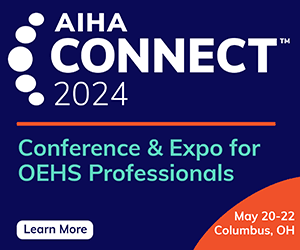Occupational Exposure Limit Values
“At ACGIH, we push OEHS professionals to utilize the most up-to-date and scientifically sound information when making decisions. To draw parallels with compliance and the progress toward worker health protection, we offer the Occupational Exposure Values guide: a side-by-side comparison of our industry-leading Threshold Limit Values and those occupational exposure values mandated and recommended by governments around the world.” Phillip Rauscher MPH, CIH, CSP, Senior Director of Science, Education & Publications, ACGIH
History & Background
An occupational exposure limit (OEL) is an upper limit on the acceptable concentration of a hazardous substance in workplace air for a particular material or class of materials. Therefore, knowing the limits is an important tool in risk assessment and in the management of activities involving handling of dangerous substances. (There are many dangerous substances for which there are no formal occupational exposure limits. In such cases, hazard- or control-banding strategies can be used to ensure safe handling.)
Historically, OELs have been established for airborne workplace chemicals by multiple regulatory and authoritative organizations around the world for more than 60 years. Given the changing regulatory arena; shifting centers of manufacturing growth; and the move towards a more global view on occupational hygiene issues, it is important that occupational/industrial hygienists understand the current and growing issues impacting the continued viability of OELs in professional practice.
OSHA has established three types of permissible/recommended exposure limits:
- Indicative limit value, set by the European Union
- Threshold limit value, set by the American Conference of Governmental Industrial Hygienists
- Occupational exposure banding, a process that can be used when not enough data are available to determine quantitative exposure limits
Key Components of the Guide
The Guide to Occupational Exposure Values is a readily accessible reference for comparison of published values from ACGIH®;(OSHA); the U.S. National Institute for Occupational Safety and Health (NIOSH); Deutsche Forschungsgemeinschaft (DFG), Federal Republic of Germany, Commission for the Investigation of Health Hazards of Chemical Compounds in the Work Area; the American Industrial Hygiene Association (AIHA); and Occupational Alliance for Risk Science (OARS). Included in the guide are the sources of the values cited, including publication dates, and the uniform resource locator (URL) if verified online (Reviewed 2019).
The Guide to Occupational Exposure Values also includes those carcinogens found in the occupational environment that are identified by the above organizations and by the U.S. Environmental Protection Agency (EPA), the International Agency for Research on Cancer (IARC) and the U.S. National Toxicology Program (NTP).
The Guide to Occupational Exposure Values is intended as a companion document to the ACGIH annual Threshold Limit Values for Chemical Substances and Physical Agents and Biological Exposure Indices (TLVs® and BEIs®) book, specifically the section on “TLVs for Chemical Substances in the Work Environment.”
This companion document to the ACGIH TLVs and BEIs book serves as a readily accessible reference for comparison of the most recently published values: 2021 Chemical Substance TLVs from ACGIH; AIHA/OARS Workplace Environmental Exposure Limits (WEELs); the OSHA Final Rule PELs; RELs from NIOSH; MAKs from the German Commission for the Investigation of Health Hazards of Chemical Compounds in the Workplace; and carcinogenicity designations from ACGIH, OSHA, NIOSH, MAK, IARC, U.S. NTP, and U.S. EPA. The book includes a CAS number index.
Resources:
- ACGIH – www.acgih.org (publications store: https://portal.acgih.org/s/store#/store/browse/cat/a0s4W00000g02f3QAA/tiles)
In addition to those sources noted above, the following were also used in preparing the Guide (Reviewed 2021).
- U.S. EPA Integrated Risk Information System (IRIS) database. A–Z List of Substances. Online at: https://cfpub.epa.gov/ncea/iris2/atoz.cfm
- Agents Classified by the IARC Monographs, Volumes 1–124. IARC, Lyon, France (1987–2020). Available online at: http://monographs.iarc.fr/agents-classified-by-the-iarc/ (Reviewed 2020)
- Report on Carcinogens, 14th Ed., U.S. Department of Health and Human Services, Public Health Service, National Toxicology Program, Research Triangle Park, NC (2016). Available online at: http://ntp.niehs.nih.gov/pubhealth/roc/index-1.html (Reviewed 2016).
Share on Socials!
ANSI/ISEA Z89.1-2014: Head Protection Guidelines
Occupational Health & Safety Management—ISO 45001:2018
Connectivity: Transforming the Industrial Hygiene Sampling Pump
Leaders in Industrial Hygiene
Council for Accreditation in Occupational Hearing Conservation (CAOHC)
Subscribe!
Sign up to receive our industry publications for FREE!










